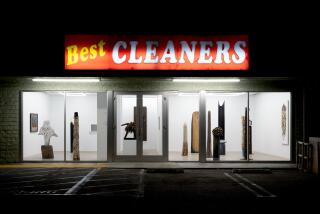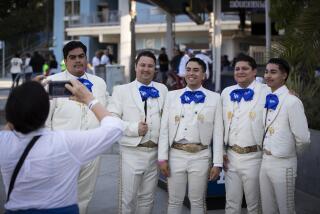Cultures, World Views Join Along the “Silk Road”
There are many things that secular entertainment can have in common with sacred ritual: a sense of high formality, a special language and location, and the comforting feeling of having order imposed on chaos. Balanchine used to say that the theater is like a church. Still, he never confused Lincoln Center with St. Patrick’s Cathedral.
In the world of Hirokazu Kosaka, however, this is not an inconceivable juxtaposition. On Friday night at Getty Center, Kosaka presented “Silk Road,” an intriguing, hourlong version of a ceremony-performance he has been orchestrating in various theatrical venues for the past 15 years.
The ingredients: Japanese archery, flamenco, a koto ensemble that can play flamenco, and Buddhist chanting. Oh, yes, and to start, a mini-festival of Japanese commercials that mix traditional Japanese imagery with cowboys and American celebrities. The idea, it seems, is that the ancient silk road was not only a commercial route, but a symbol of cultural encounters.
There are slow processions, a line of church ladies who delicately tap bells for Buddhist hymns and verses; Kosaka himself gravely shooting one arrow into a makiwara (straw target); and three wonderful koto players with zestful, fluctuating rhythms.
The heart of the performance is a layering of two different traditions: Buddhist chanting by clergymen upstage, and flamenco downstage. Two dancers (Sylvia and Cynthia Morales) first hear the low, insistent chanting as if they are in a dream; then they become lost in their own world with guitarist Philip Boroff.
For a long while, the two forms interact interestingly--not that this is fusion; there is no jamming, just an occupying of the same space. The priests are seemingly oblivious to (perhaps even annoyed by) the brisk strumming of the guitar and the escalating fervor of the dancers. Chanting, riffling prayer fans or striking the taiko drum, they use utilitarian gesture and look inward for spiritual resonance. The flamencos also court the spiritual, the duende, and also look inward; but theirs is a restless, outward search through curving, decorative movement.
Sometimes the rhythms meet in cosmic, serendipitous polyphony; sometimes the flamenco music ebbs and the stark vocalizations seem sternly independent, out of step. One is theater, one is prayer--both are performances of seeking. Are they on the same road? Your call.
More to Read
The biggest entertainment stories
Get our big stories about Hollywood, film, television, music, arts, culture and more right in your inbox as soon as they publish.
You may occasionally receive promotional content from the Los Angeles Times.










